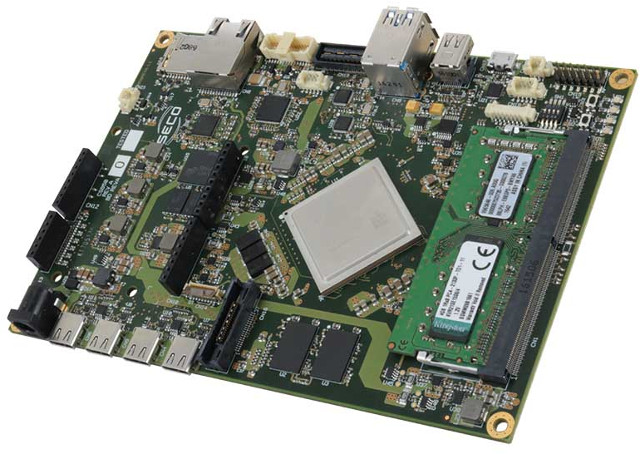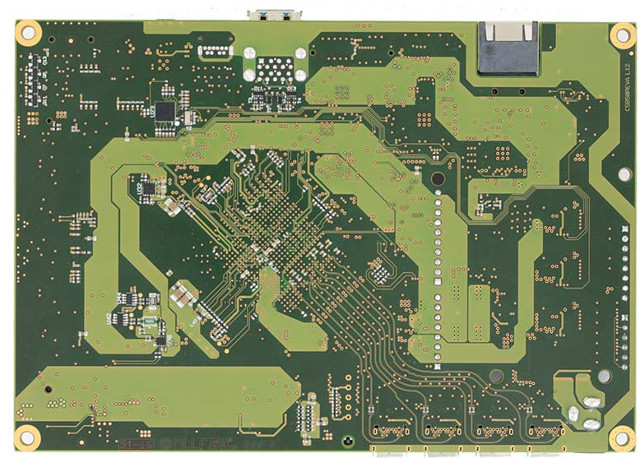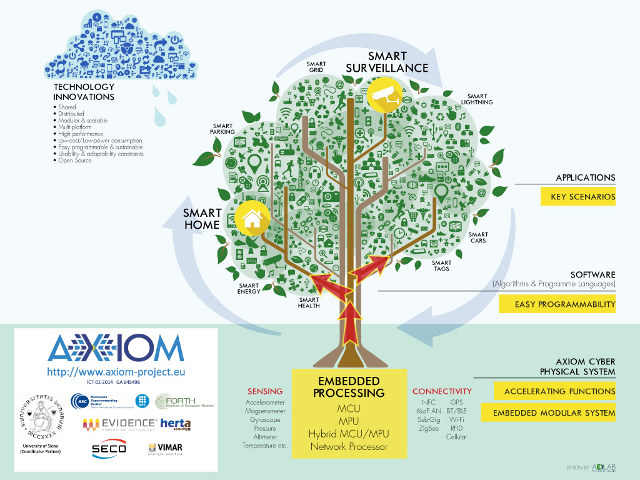Back in 2015, Xilinx unveiled Zynq Ultrascale+ MPSoC combining ARM Cortex A53 & Cortex R5 cores, a Mali-400MP2 GPU, and UltraScale FPGA, and the company recently launched ZCU102 Evaluation Kit based on the SoC, which sells for just under $3,000. But if you are based in the European Union, you’ll be glad to learn about 4 millions Euros of your taxes have been spent to design a board based on the same MPSoC family as part of the AXIOM project, which was developed in collaboration with European universities and companies with the “aim of researching new software/hardware architectures for Cyber-Physical Systems (CPS) to meet the expectations” in terms of computational power, energy efficiency, scalability through modularity, easy programmability, and leverage of the best existing standards at minimal costs.
 AXIOM (Agile, eXtensible, fast I/O Module) board’s key specifications:
AXIOM (Agile, eXtensible, fast I/O Module) board’s key specifications:
- SoC – Xilinx Zynq Ultrascale+ ZU9EG MPSoC with four ARM Cortex A53 cores @ 1.2GHz, two Cortex R5 “real-time” cores @ 500MHz, a Mali-400MP GPU @ 600 MHz, 600K System Logic Cells;
- System Memory – 32 GB of swappable SO-DIMM RAM (up to 32GB) for the Processing System, plus a soldered 1 GB Programmable Logic.
- Storage – 8 GB eMMC flash (PCN layout supports up to 32GB), and a micro SD card reader.
- Display – miniDP connector, single channel 24-bit LVDS interface, touch panel connector
- Connectivity – Gigabit Ethernet port (RJ45)
- USB – 4x USB Type C ports, 2x USB Type A ports
- Expansion
- Arduino UNO headers
- 12x GTH transceivers @ 12.5 Gbps (8 on USB Type C connectors + 4 on HS connector)
There’s also mention of an Axiom Link interface that would allow to interconnect multiple AXIOM boards in order to arrange small clusters.
 Since it’s a public project I would have expected it to be open source. While there are some deliverables available for download, they appear to be outdated with “the technical specification of AXIOM board” PDF mentioning only AXIOM-15 and AXIOM-35 boards based on the previous Xilinx Zynq-7000 series SoCs. We can also find links to a Wiki, as well as git and svn repository, but all those are in a private area that requires a login, and as far as I could tell, it’s not possible to register. So maybe the EU commission wants to protect its investment, or we just need to be a little more patient. [Update: This Download page seems to have more public info available]
Since it’s a public project I would have expected it to be open source. While there are some deliverables available for download, they appear to be outdated with “the technical specification of AXIOM board” PDF mentioning only AXIOM-15 and AXIOM-35 boards based on the previous Xilinx Zynq-7000 series SoCs. We can also find links to a Wiki, as well as git and svn repository, but all those are in a private area that requires a login, and as far as I could tell, it’s not possible to register. So maybe the EU commission wants to protect its investment, or we just need to be a little more patient. [Update: This Download page seems to have more public info available]

The AXIOM Board is said to combine features required for High-Performance Computing, Embedded Computing and Cyber-Physical Systems, with typical applications including real-time data analysis of a huge amount of data, machine learning, neural networks, server farms, bitcoin miners, and so on.
It’s unclear when/if the board will be available for sale, and at what price.
Via Board DB and Single Board Computers G+ community.

Jean-Luc started CNX Software in 2010 as a part-time endeavor, before quitting his job as a software engineering manager, and starting to write daily news, and reviews full time later in 2011.
Support CNX Software! Donate via cryptocurrencies, become a Patron on Patreon, or purchase goods on Amazon or Aliexpress





I’m tempted to say that’s a great board, but I won’t until I hear the pricetag ; )
Funny similarity with the Apertus open source camera: it’s also called Axiom, and is also using Zynq FPGA!
There many devices based on variations on this Soc, i found plenty just by doing a search. What articles I found and read on the Axiom project seem to suggest a lot of the software is in development. It aims basically to develop smart, thinking, IOT.
Xilinx’s own forum and website have products, software, and user comments. There is a Linux for the xilinx soc and a evaluation kit
“. The ZCU102 Evaluation Kit enables designers to jumpstart designs for Automotive, Industrial, Video and Communications applications. This kit features a Zynq UltraScale+™ MPSoC device with a quad-core ARM® Cortex-A53, dual-core Cortex-R5 real-time processors, and a Mali-400 MP2 graphics processing unit based on Xilinx’s 16nm FinFET+ programmable logic fabric. The ZCU102 supports all major peripherals and interfaces enabling development for a wide range of applications.”
Costs 2,450.00 GBP
@theguyuk
Evaluation kits always about $3000, hopefully this boards costs a whole lot less. If their stated aim is to support IoT, then it has to be in the $50-$100 range
@nutjob2
FPGA SoCs are always more expensive, and depending on the production volume I’m expecting something more toward the $200-$400 range.
@blu @nutjob2
I think this is aimed more at development than actual end product, more a kit to dream new products on and design the software hardware to enable such dreams. One of the aims is a intelligent home heating sensor and the other surveillance cameras that track people, objects across multiple screens, big data they call it.
@blu
Yes, but I was hoping they made a deal and managed to get the price down. You’re probably right though.
Maybe they’ll subsidise the boards for EU residents and make them cheap that way. I won’t be holding my breath.
Wait, what ???!!! These guys got 3 million euros of taxpayer’s money and all you get is a 3000€ dev kit that has hardly more processing power than a pair of raspberry pis ?! Did I miss something ?
@Lou
We don’t know the exact price yet, but it’s much more powerful than the Raspberry Pi. There’s an FPGA with 600K cells and multiple high speed transceivers, 32GB RAM, etc…
FPGAs can be very expensive items with the most advanced chips costing around $40,000, as you can see for Xilinx XC7V2000T-G2FLG1925E @ https://octopart.com/search?q=+XC7V2000T-G2FLG1925E
Xilinx Zynq Ultrascale+ ZU9EG will cost much less than that, but I could not find the exact price. You’ll find some price for other Zynq Ultrascale+ SoC @ https://octopart.com/search?&q=ultrascale%2B+mpsoc&start=0, and the entry level chips of that family like ZU2CG and ZU3CG cost $350 and up. (Page 2 of the link)